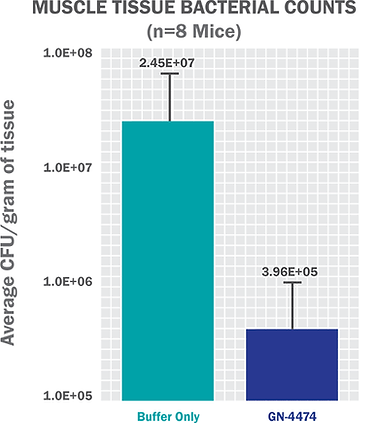
GN-4474 Conjugation-Mediated Killing Technology to Treat Gram-Negative Bacterial Infection
Gram negative bacteria cause numerous infections including pneumonia, bloodstream infections, wound or surgical site infections, and meningitis.

Gram negative bacteria can cause infections in many parts of the body including the lung (pneumonia), urinary tract, bloodstream, skin (including burns and traumatic wounds, ulcers, and surgical sites), the brain and spinal cord (meningitis), and multiple other organs and tissues.
Gram-negative bacteria include many common pathogens including Pseudomonas aeruginosa, Acinetobacter baumannii, and a large family of related enteric bacteria including Escherichia coli, Klebsiella pneumonia, Proteus mirabilis, and many others. Gram-negative bacterial infections can be as benign as Swimmer's Ear to very serious diseases such as food poisoning, meningitis, Legionnaires' disease, plague, cholera, dysentery, and sexually transmitted diseases such as gonorrhea.
Infections caused by Gram-negative bacteria can be difficult to treat because of their unique features, including the nature of their cell wall which makes them resistant to several classes of antibiotics. Certain types of Gram-negative bacteria have become increasingly resistant to nearly all available antibiotic drugs. This has also increased illness and death from bacterial infections, heightened the challenge for healthcare facilities, and contributed to escalating healthcare costs.
How It Works

Efficacy
GN-4474 Reduces Established Infection 100X in 24 hours
Treatment with GN-4474 (■) reduced infection by an average of 98%, and half the animals showed no signs of infection compared to untreated controls (■). Furthermore, treatment with GN-4474 prevented sepsis in the same animals (not shown).


Wounded mice infected with antibiotic-resistant Psuedomonas aeruginosa died within 2 days, without treatment with GN-4474. All wounded, infected mice survived with a single application of GN-4474 (high dose).
Gram-negative Bacteria Do Not Develop Resistance
-
Pathogenic bacteria were exposed to GN-4474 in vitro; surviving bacteria were re-exposed to GN-4474, repeatedly up to 20 times, to try and force the development of resistance.
-
If the bacteria became resistant, survival would increase and the blue line (■) would trend upwards towards the turquoise line (■) controls over time.
-
There is no evidence that these pathogenic bacteria are developing resistance to GN-4474.

